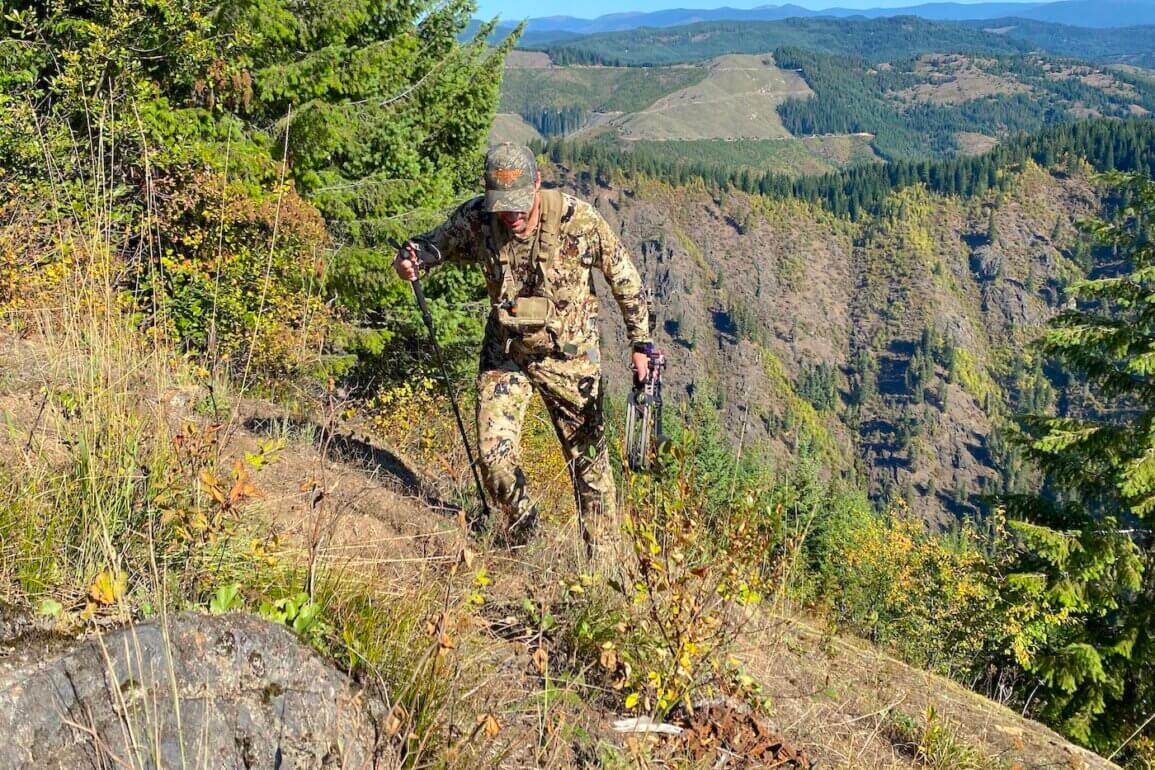The new Sitka Core Merino Wool Collection is a lineup of merino wool base layers in three weight classes. Sitka now offers merino shirts and bottoms for warm-weather early-season hunting as well as cold-weather options.
To get us a closer look, Sitka Gear sent Man Makes Fire a men’s Core Merino 120 LS Crew for testing and review. Man Makes Fire gear reviewer Chris Maxcer took it out hunting during September archery elk hunts to test its real-world performance. To help you determine if the Sitka Core Merino base layers are right for you, here is what he learned and his buying recommendations:
Review: Sitka Core Merino 120 LS Crew Shirt
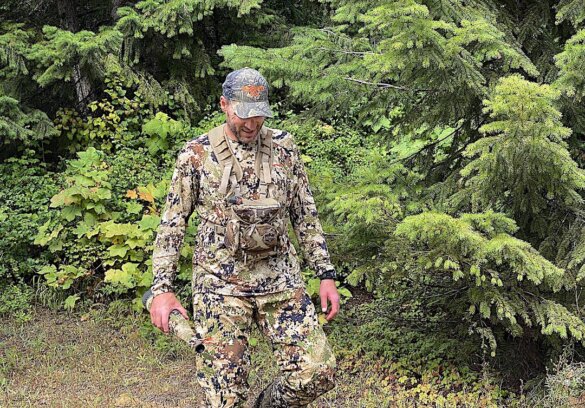
I am a big fan of merino wool base layers. I prefer merino wool over most synthetic base layers because merino wool has excellent thermoregulating properties that somehow help you not overheat in warm weather yet also keep you warm in cold weather. In addition, merino wool has excellent odor control. Merino wool makes it hard for bacteria to get a foothold in the fibers and create a stinky, funky smell. If your fully synthetic base layers and shirts develop a funky smell, particularly after multi-day use in the backcountry, merino wool is for you.
Meanwhile, what about the Sitka Core Merino 120 LS Crew Shirt? Is it the right merino base layer for what you need? When I wore the new Core Merino 120 LS Crew this September while hunting elk in Idaho, I was impressed by the shirt’s overall performance. In fact, it’s now my new favorite base layer because it excelled so well during the testing process.
How I Tested the Core Merino 120 LS Crew

I wore the Core Merino 120 for 10 days while hunting before writing this review, including wearing it repeatedly every day for five straight days. On each of these days, I wore the Core Merino 120 next-to-skin, sometimes with a layer or two over the top on cold mornings. On every day, I wore a Mystery Ranch Sawtooth 45 hunting pack as well. Up to the point of this writing, we covered more than 80 miles on foot over rugged terrain with lots of sweat-inducing elevation gain and loss.
Despite many long, hot and sweaty days, the Sitka Core Merino 120 LS Crew never developed any stink. In my experience, some competitive merino wool blended shirts have eventually started stinking, but this Sikta layer did not on me. And I tend to sweat quite a bit.
Shop the complete ‘Core Merino Collection’ at Sitka for the most size, color, a camo options!
How Does Sitka’s Core Merino Feel?
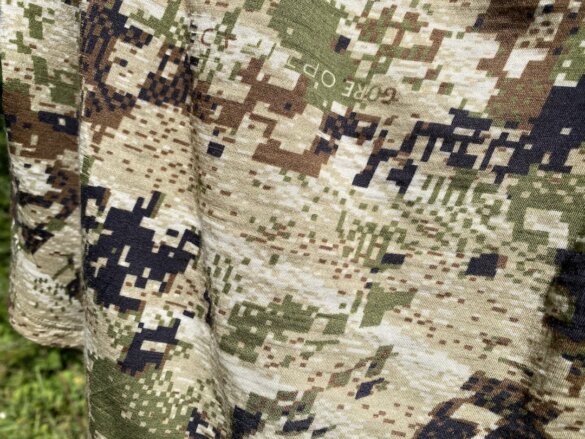
Lots of people expect wool base layers to itch. Some wool base layers are itchy, and most high quality 100% merino base layers woven with thin threads are only slightly itchy in my experience. The Sitka Core Merino 120 LS Crew feels fantastic on bare skin. I was surprised. For me, most competitive merino base layers start out feeling very slightly rough when I first put them on . . . and after a couple of minutes, I get used to it and forget about it.
The new Sitka Core Merino requires no such transition time. It feels smooth from the moment I put it on. Surprisingly good, in fact. No doubt this has to do with the synthetic nylon fibers blended into the weave.
Sitka’s extra-durable ArmorSpun merino wool is legit
To make the fabric, Sitka uses a 17.5 micron merino wool, which is a superfine merino.
The drawback to 100% merino base layers is that they tend to stretch and lose their shape over time. They usually snap back after washing, but if you’re wearing a layer over multiple days — for example while hunting — this stretch is annoying at best. Merino wool is also generally not as durable as synthetics.
To combat the stretch, some apparel makers wrap merino wool fibers around nylon fibers to create a core-spun merino-nylon blend. This tends to make the fabric stronger. So far so good.
But Sitka does something a bit different from the competition: Instead of wrapping merino around a nylon core, Sitka is wrapping nylon around a merino core. That change has resulted in a merino fabric retains the best properties of wool while making it stronger. In fact, Sitka calls its innovative new wool ArmorSpun merino.
How Is the Core Merino Durability?
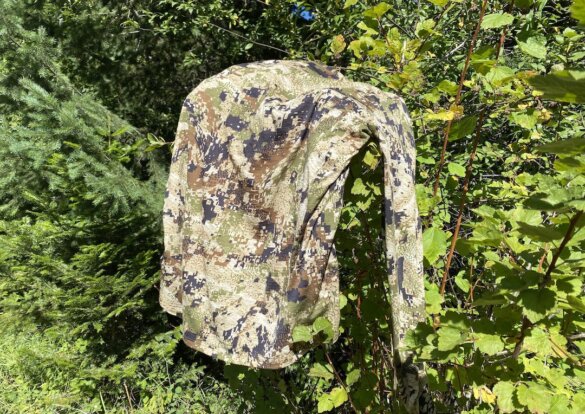
Sitka claims its ArmorSpun merino is stronger and more abrasion-resistant than typical competing core-spun merino blends. So is the new Core Merino strong?
On most days while hunting in September, at some point in the day, usually by mid-morning, I wore the Sitka Core Merino 120 LS Crew as my only layer because it was warm enough to do so.
And, on most days, I walked through dense brush and thick forest terrain. Many many branches brushed over my arms and torso. I plowed through so many branches, which is typical when you bow hunt elk in north Idaho, that I don’t believe a 100% merino wool shirt would have held up.
The Sitka Core Merino 120 LS Crew held up. In fact, I’m stunned by how durable the new ArmorSpun Core Merino is. At one point, I walked by a wild rosy thorn bush with massive thorns and caught my arm and sleeve. I thought, “Oh, now this is where the Core Merino finally snags and tears.”
But as I extracted myself and the shirt from the thorns, I couldn’t even see where the thorns had pierced the ArmorSpun fabric. No rips, no visible snags.
I was impressed.
So far I’ve washed and dried the Core Merino 120 LS three times — and it hasn’t started to pill up. By the way, Sitka says you can wash your Core Merino gear with all your other apparel — no special laundry rules apply. Nice.
How Does the Core Merino Fit?

For the me, the Sitka Core Merino 120 LS Crew fits perfectly as expected. I’m about 6’3″ and weigh 220 lbs and typically wear a size XL shirt, base layer, or jacket. The XL fit trim-but-not tight. If you want a tighter fit, you could likely size down. I would not recommend sizing up for anyone, though.
The sleeve length is perfect with thumb holes to make it easier to pull on layers over the top. I have slightly long arms and appreciated the coverage. The sleeve cut is relatively trim, which I also appreciate, particularly when layering or shooting my bow.
Matching Camo Options
While you can dye 100% merino wool most any color, it doesn’t hold camo patterns particularly well — which is why so many wool base layers, even from hunting companies, don’t offer 100% merino camo shirts.
Sitka’s new ArmorSpun merino fabric, in contrast, lets Sitka print crisp versions of its camo patterns on the Core Merino series. The result is that you can remove layers as the day heats up and maintain your camo profile while hunting. For me, for archery hunting, being able to wear a seamless camo pattern that matches my Sitka hunting pants, is a massive benefit.
How to Understand Your Version Options
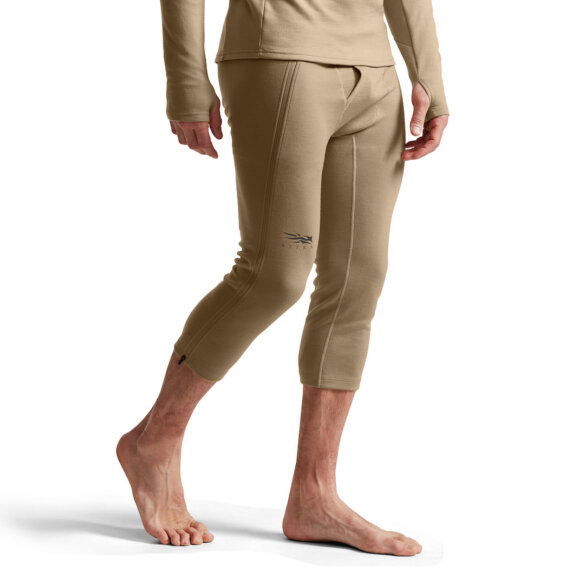
The SITKA Core Merino Wool Collection is comprised of a three-tier system with different weights to help you choose the right level of fabric:
120 gram: lightweight, great for early-season hunts
220 gram: midweight, great do-it-all base layer
330 gram: heavyweight, great for cold, late-season hunts
Most competitive merino wool base layers or outdoor apparel use a grams per square meter metric to identify the relative weight of the fabric (a.k.a. gsm or g/m²). Lightweight merino apparel will be in the 100s, midweight 200s, and heavyweight 300s. When you’re buying merino base layers online, the relative weight helps you identify what kind of weather it’s intended for.
So, shirts and bottoms in the Core Merino 120 series are lightweight — similar to a thin cotton t-shirt. The Sitka Core Merino 220 series is essentially a doubling of the 120 series weight — kind of like a heavyweight cotton t-shirt. The Core Merino 330 series is even thicker, but it uses a slightly different construction: It adds a layer of polyester on the interior that wicks moisture to the outer ArmorSpun merino layer.
Shop the complete ‘Core Merino Collection’ at Sitka for the most size, color, a camo options!
Competitive Alternatives & Options
In case you’re wondering, Sitka doesn’t reveal the percentage of merino wool blend in its Core Merino Collection. I suspect this is to avoid competitive posturing and comparisons. As you try to decide which merino base layer is right for you, I recommend that you error toward merino blends if you want to maintain camo patterns and occasionally wear your base layer as your only layer. For Sitka outdoor apparel fans who already own Sitka camo patterns, you can now choose from the Core Merino collection and maintain excellent merino-grade performance. If you have a different camo preference — or have no need for camo or are ok with mixing and matching camo patterns — these competitive camouflage merino wool base layers might also meet your needs:
KUIU Ultra Merino 120 LT LS Crew-T — The KUIU Ultra Merino 120 LT SS Crew-T uses a core-spun 70/30 merino/nylon blend. Like the Sitka Core Merino collection, KUIU uses soft and fine 17.5-micron merino fibers. Another key benefit is shared between KUIU and the Sitka base layers: The shoulder seams are placed to the front and back for added comfort under shoulder straps on hunting backpacks. I’ve worn KUIU’s Ultra Merino 120 short-sleeve version hunting and it’s very good. I think the Sitka Core Merino is very slightly softer on bare skin than the KUIU equivalent, but if you’re a KUIU camo fan, there’s no reason to stray here.
First Lite Wick LS Crew — During last year’s archery elk season, I tested the short sleeve version of this First Lite base layer and came away impressed. Compared to the Sitka Core Merino 120, the 150-weight fabric is nearly indistinguishable in thickness. Next-to-skin comfort is excellent. One key difference is the use of 37.5 Technology in the nylon-blended fibers, which helps the Wick series dry fast due to the addition of some microscopic volcanic sand particles. If you don’t need the First Lite camo pattern to match your Sitka or KUIU camo, the First Lite performance is very competitive.
BlackOvis Venture Merino Long Sleeve Crew — BlackOvis-branded apparel tends to give you hunting-ready clothing at more competitive price points. BlackOvis’s Venture Merino line features 95% merino wool with 5% Spandex. The biggest benefit is excellent thermoregulation that won’t stink. The biggest drawback is that it will shrink if you dry it in a clothes dryer. Also, the Venture series is offered in muted color tones but isn’t available in camo patterns.
The Bottom Line
All-in-all, the Sitka Core Merino 120 LS Crew is a do-it-all early-season merino base layer that you can wear as your only layer when temperatures rise. Next-to-skin comfort is excellent, as is thermoregulation and odor performance. The Sitka ArmorSpun merino/nylon blend is legit — surprisingly durable against Idaho brush, branches and even thorns. Very highly recommended.
Get the Gear:
Check pricing & availability buying options:
BlackOvis | Sportsman’s Warehouse | Scheels
Our Gear Review and Tester’s Specific Related Experience:
Chris Maxcer has tested and reviewed several merino base layers for Man Makes Fire. He’s personally worn merino base layers while skiing, backpacking, hiking, hunting and fishing in the field to understand how well they hold perform in real-world usage, how they fit, stretch, wick moisture, thermoregulate, and maintain their shape through on-mountain use as well as washing and drying. Of course, Maxcer has also written hundreds of in-depth outdoor gear reviews, including independent, first-hand reviews of fly fishing gear, camping gear, hunting gear, backpacking gear, and beach and water play gear. He believes the best way to understand a product is to use it in the real world for the kind of activity it was designed for.
Man Makes Fire publishes independent gear reviews, unencumbered by any requirements from any gear brand or manufacturer.

